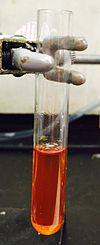
Back Ysterpentakarboniel Afrikaans خماسي كربونيل الحديد Arabic پنتاکربونیل دمیر AZB Pentacarbonil de ferro Catalan Pentakarbonyl železa Czech Eisenpentacarbonyl German Pentacarbonilo de hierro Spanish پنتاکربونیل آهن Persian Rautakarbonyyli Finnish Pentacarbonyle de fer French

| |

| |

| |
| Names | |
|---|---|
| IUPAC name
Pentacarbonyliron(0)
| |
| Other names
Pentacarbonyl iron
Iron carbonyl | |
| Identifiers | |
3D model (JSmol)
|
|
| ChEBI | |
| ChemSpider | |
| ECHA InfoCard | 100.033.323 |
PubChem CID
|
|
| RTECS number |
|
| UNII | |
| UN number | 1994 |
CompTox Dashboard (EPA)
|
|
| |
| |
| Properties | |
| Fe(CO)5 | |
| Molar mass | 195.90 g/mol |
| Appearance | straw-yellow to brilliant orange liquid |
| Odor | musty |
| Density | 1.453 g/cm3 |
| Melting point | −21.0 °C (−5.8 °F; 252.2 K) |
| Boiling point | 103 °C (217 °F; 376 K) |
| Insoluble | |
| Solubility | Soluble in organic solvents slightly soluble in alcohol insoluble in ammonia |
| Vapor pressure | 40 mmHg (30.6 °C)[1] |
Refractive index (nD)
|
1.5196 (20 °C) |
| Structure | |
| D3h | |
| trigonal bipyramidal | |
| trigonal bipyramidal | |
| 0 D | |
| Hazards | |
| Occupational safety and health (OHS/OSH): | |
Main hazards
|
Very toxic, highly flammable |
| GHS labelling: | |
  
| |
| NFPA 704 (fire diamond) | |
| Flash point | −15 °C (5 °F; 258 K) |
| 49 °C (120 °F; 322 K) | |
| Explosive limits | 3.7–12.5% |
| Lethal dose or concentration (LD, LC): | |
LD50 (median dose)
|
25 mg/kg (rat, oral) |
| NIOSH (US health exposure limits): | |
PEL (Permissible)
|
none[1] |
REL (Recommended)
|
TWA 0.1 ppm (0.23 mg/m3) ST 0.2 ppm (0.45 mg/m3)[1] |
IDLH (Immediate danger)
|
0.4 ppm[1] |
| Safety data sheet (SDS) | ICSC 0168 |
| Related compounds | |
Related compounds
|
|
Except where otherwise noted, data are given for materials in their standard state (at 25 °C [77 °F], 100 kPa).
| |
Iron pentacarbonyl, also known as iron carbonyl, is the compound with formula Fe(CO)5. Under standard conditions Fe(CO)5 is a free-flowing, straw-colored liquid with a pungent odour. Older samples appear darker. This compound is a common precursor to diverse iron compounds, including many that are useful in small scale organic synthesis.[2]
- ^ a b c d NIOSH Pocket Guide to Chemical Hazards. "#0345". National Institute for Occupational Safety and Health (NIOSH).
- ^ Samson, S.; Stephenson, G. R. (2004). "Pentacarbonyliron". In Paquette, L. (ed.). Encyclopedia of Reagents for Organic Synthesis. New York, NY: J. Wiley & Sons. doi:10.1002/047084289X. hdl:10261/236866. ISBN 9780471936237.
© MMXXIII Rich X Search. We shall prevail. All rights reserved. Rich X Search
